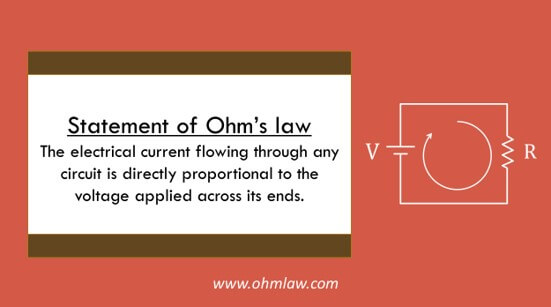Ohm’s Law Statement
Ohm’s law statement: The current flowing through a resistor is directly proportional to the potential difference (voltage) applied across its ends.
Mathematical statement of Ohm’s Law: V = IR
The above two lines explain the original statement of Ohm’s law. We can expand the law to derive the relationship between voltage, current, and resistance.
Explanation of Ohm’s law statement
For a constant resistance, the amount of current flowing through a circuit is directly proportional to its voltage.
Now, V ∝ R
Let’s consider two cases for a better illustration.
Example # 1: A potential difference of 5 volts is applied to a 10 Ω resistor. Find the current flowing through it.
Solution: From Ohm’s formula, I = V/R = 5 V / 10 Ω = 0.5 A
Example # 2: A potential difference of 10 volts is applied to 10 Ω resistor (Since resistor is constant). Find the current passing through it.
Solution: I = V/R = 10 V / 10 Ω = 1 A
By comparing above cases one can understand that for a constant resistance (10 Ω) the amount of current increases when we increase the voltage.
Statement for constant voltage
The electrical current flowing through any circuit is inversely proportional to its resistance.
Now, for a constant voltage, statement will become: I = V/R → I ∝ 1/R
The current is inversely proportional to the connected resistor. The two examples below better illustrate the above statement.
Example # 3: A voltage source of 5 V connects to a 10 Ω resistor, find the current flowing through it.
Solution: From formula, I = V/R = 5 V / 10 Ω = 0.5 A.
Example # 4: A voltage source of 5 V connects (Since the source is constant), with a 20 Ω resistance, find the current flowing through it.
Solution: I = 0.25 A.
From above two examples, one can understand that by increasing voltage the current decreases.
Statement for Constant Current
The amount of voltage dropped across any circuit is directly proportional to its resistance.
Now, V ∝ R
The two cases below better illustrate this,
Example #5: Find the amount of voltage applied across 10 kΩ resistor when a current of 5 mA flows through it.
Solution: V = IR = 5 mA * 10 kΩ = 50 V
Example # 6: Find the amount of voltage applied across the 20 kΩ resistor when a current of 5 mA (since current is constant) flows through it.
Solution: V = IR = 5 mA * 20 kΩ = 100 V.
By comparing both cases one can understand that amount of voltage increases when the resistor increases.
